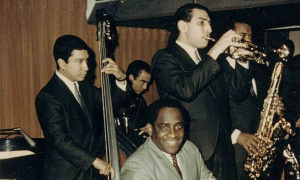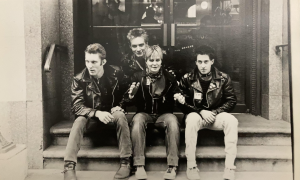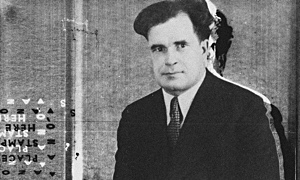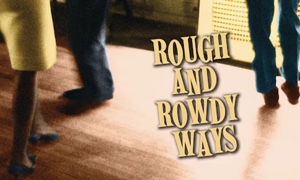Home » Jazz Articles » Hardly Strictly Jazz » Your Past Will Come Back To Haunt You: Omnivore and Dus...
Your Past Will Come Back To Haunt You: Omnivore and Dust To Digital - Two Record Labels That Matter
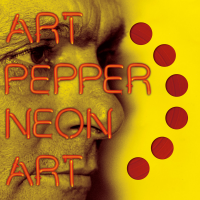 When I was growing up, a great many labels actually worked hard at having an identity. Blue Note meant something, as did Stiff, Rounder, Sugar Hill, Fania and many more (even some of the majors). Music fans actually bought stuff with a sense of trust for the people who put it out. Packaging, production style, taste, and aesthetic pointed to (big idea) a real live art vision behind each release.
When I was growing up, a great many labels actually worked hard at having an identity. Blue Note meant something, as did Stiff, Rounder, Sugar Hill, Fania and many more (even some of the majors). Music fans actually bought stuff with a sense of trust for the people who put it out. Packaging, production style, taste, and aesthetic pointed to (big idea) a real live art vision behind each release. I've worked with and for several reissue labels, and there are basically two kinds: The cheap "just throw it out there" chop shops, and those run by stone music fanatics who invariably wind up spending more than they'd intended because the music and package had to be just so. And these fanatics ran weird little labels that somehow stayed in business even as the industry was imploding around around them. Stubborn resolve plus the irrational love of music often equals longevity.
And so, the brick and mortar record company idea hasn't been killed off, even as digital distribution has largely removed tactile contact from the music experience. There are a few indie labels—Omnivore and Dust To Digital prominent among them—whose releases are wonderful objects. Both focus mostly on reissue/unreleased archival material, and each has matched distinctive musical taste with packaging that sings out loud.
On the surface, the two seem very different. Omnivore is chaired by Cheryl Pawelski, a real-live vetted Grammy-nominated Hollywood major label insider, while Dust To Digital is a tiny Atlanta label run by Lance Ledbetter and his wife April. Pawelski's aesthetic is wide. She's worked on box sets from Big Star to John Coltrane, knows more about major label catalogs and music business procedure than any human I've ever met, and is a third degree black belt record geek. Ledbetter's operation is mom-and-pop-shop all the way, and his focus is almost entirely on vernacular music, not strictly American. Pawelski is much more likely to traffic in artists you've heard of than is Ledbetter, who will point right at something whose very existence you never even suspected. But each of these labels is the creation of someone with a real aesthetic, an abiding love, and a creative notion as to how to present recorded music.
Why do we need these people and what they do? Can't we just stream it all on Spotify or something?
"The bottom line is always the music," says Pawelski, "but what about putting it in a context? A digital file doesn't give you that at all.You don't get a picture, or liner notes. There used to be so much that literally surrounded the music—cover art, notes, even the label design—that were like clues before you even put the record on. The whole thing pointed to something, meant something. It drew you in and made you a fan. When your favorite band was going to put out a new record, you didn't just wonder about the songs. You waited to see the cover, too. A new record was an event, not a file. The great labels had a real identity. I collected all those Sub Pop mail order singles, and I loved the slogan on the envelope—'Going Out Of Business Since 1988'—and the music and just the whole attitude. I trusted them to make a good record. They kept me curious."
Dust To Digital's packages don't just induce curiosity—they force it. Their Grammy-nominated inaugural release, Goodbye, Babylon (2003), was a five CD set of American gospel music and sermons, 1902-1960. The discs (and a 200 page book with Bible verses, lyrics, and serious notes) come in a 12" box packed with cotton. This anthology is a landmark. Nobody had anthologized gospel music so comprehensively, and no reissue ever looked like this.
"It's American music from an earlier time," explains Ledbetter, "and I wanted Goodbye, Babylon to be recognizable to the people who made the records or who bought them in that time, during that period. If you look at pictures of stores or old catalogs from, say, the thirties, you see wooden boxes. So I searched and found a company that does cedar wine boxes with corporate logos, and we cut a deal with them for a thousand. We've pressed up more copies with each run, same company. It's not really that expensive to do, but the dimension it adds to the story you're trying to tell... Well, it means something."
Clearly, it does. Neil Young spoke of it on NPR's Weekend Edition:
"I recently got a gift from Bob Dylan, a good old friend of mine. He gave me a gospel collection of great old American music and early country roots from old 78s. It's the original wealth of our recorded music; it's the cream of the crop and has the history of each recording. It's a great old set called Goodbye, Babylon, and it's incredible. It's in a wooden box and everything, and it's just so beautiful."
(Ledbetter admitted to falling out of his chair upon hearing this.)
Babylon, largely because it was Ledbetter's maiden voyage, took four and a half years to complete. He started the project while still employed full time as the main computer guy at a small Atlanta company in an office environment. He had previously worked at Table Of The Elements, an Atlanta indie label specializing in experimental music, and had learned a few things by the time he started DTD. Pawleski—because of her direct reissue experience and existing relationships—takes a much more streamlined approach to the process, but her affection for music arcana has also resulted in striking, joyous releases, and more of them than Dust To Digital is likely to manage anytime soon. Omnivore's mining of the Buck Owens catalog has been particularly interesting and gives an insight as to the real personality and imagination behind their releases .
Buck Owens has often been given short shrift by the people who knew him in the seventies as the inanely grinning co-host of Hee Haw, a show whose often agonizing cornball comedy too often obscured the high quality of its musical content. In the sixties, Owens was damn near a one man reign of terror against the Nashville establishment, with eighteen number one singles on the country charts, all of which were cut in Hollywood. His trebly California country music combined high lonesome harmonies (he and lead guitarist Don Rich were a magic frontline harmony duo) with big twanging Fender guitars (featuring Rich playing some of the most acrid, biting Telecaster ever put on record). Buck Owens and the Buckaroos were to Nashville the same type of perceived threat Dizzy Gillespie was to Louis Armstrong. And, as with Diz and Pops, Buck and the Nashville old guard eventually came to affectionate terms.
Buck was a big thinker, commercial opportunist, and very much a guy with an eye to technology (he bought the second Moog syntheszier ever sold). No doubt the opportunity to travel the spaceways appealed to him. When Omnivore decided to reissue Buck Owens Live At The White House... And In Space (a 1972 Capitol release of his 1968 performance done at the behest of President Lyndon Johnson), they included a special recording Owens and the Buckaroos did in 1972 for the astronauts aboard Apollo 16, . Patrick Milligan—who produced a great many of Rhino's best box sets—was doing tape research at the Owens estate when he happened across the largely forgotten Apollo 16 tapes. Country LP's of the era were notoriously light for minutes (quite often under thirty minutes), so here was a real coup of appropriate bonus material.
Knowing Owens' proclivity for technology (which lasted to the end of his life), he had to have taken a proud and special pleasure in playing a country show for a captive space crew. The performance is loose and joyous as well, Buck basically doing an old style live country radio show with jokes and music, and the band playing live in the studio. It's a sleeper classic, and captures Buck at the end of his great period, which ended officially in 1974, with Rich's untimely death (motorcycle accident).
(Buck was, by the way, an avid Republican, and the White House concert's '72 release date has lead many to incorrectly presume the performance happened at the behest of President Richard Nixon, a fellow California Republican. Owens did socialize with him as well as well as being quite friendly with Ronald Reagan, dating back to the latter's sixties stint as governor of California.)
By far the most unique and distinctive Owens item from Omnivore is The Buck Owens Coloring Book, which comes complete with an enclosed flexidisc of four songs from the White House performance.
Flexidisc?
Flexidiscs—records pressed on very thin vinyl and generally included in magazines—were everywhere in the seventies, but had become rare by the late eighties. Eventually, only the Evatone company still manufactured them, and they finally discontinued the format in August, 2000 (well into the post-vinyl era, it should be noted). In 2010, Pirates Press, a punk oriented pressing plant in Northern California, revived the format. The flexi most people knew was one of underground whale sounds, which came in the January 1979 National Geographic. Since it was included in every copy of that issue, it had an initial press run of 10,500,000, making it the largest single pressing of any record in history.
"That was for Record Store Day," explains Pawelski. "The coloring book was commissioned by Buck and made in 1970. No one is exactly sure if they were ever released back in the day, but they have been sporadically available at the Crystal Palace, Owens' Bakersfield dancehall, steakhouse, and museum. (Owens estate administrator) Jim Shaw helped us obtain the original books. I knew about it because I bought a copy on the collectors market years ago—I collect all sorts of music related ephemera too—and that's how I knew about it. I don't know how many were initially printed but we picked up around 3000 more or less, and we did the flexidisc to go with it. We also put a download card so people wouldn't have to pull it apart. Putting a flexidisc in there made it more authentic to 1970 than if we'd just put a download card, and it made the whole thing"—she pauses—"just right. In the context of a Buck Owens coloring book from 1970, what could be more appropriate than a flexi?"
"We don't do just one type of format" she continues. "Each project has its own context, and that drives what the format will be. I mean"—she points to a copy of Neon Art that sits between us on a coffeeshop table. It's a red neon vinyl LP of Art Pepper that consists of two extended live performances taken from a 1981 gig. The album cover is diecut to reveal the colored vinyl, which tints Pawelski's cheek orange as she picks up the LP and holds it to the light—"Look at this. Somebody maybe even who doesn't know who Art Pepper is, why wouldn't they look twice at this? If we can get some seventeen year old kid to check out Art Pepper and read (Pepper's autobiography) Straight Life, how cool would that be?"
(If it keeps them 'em off drugs...)
Arriving at context is often as utilitarian as it is aesthetic.
"In the cases of some of what we put out, we might have the rights to vinyl but not digital," she continues. "Some stuff, it might not really make sense to do LP's but CD's are fine, or—if it's something really ephemeral, a digital-only release might be best. If it's something like (seventies Bay Area soul singer) Darondo, the audience for that is vinyl at least as much as CD, so why not? And, if you're gonna do vinyl, why not colored vinyl?"
Ledbetter agrees.
"Some of these things—especially since we do things that have extensive packaging like books—define themselves. We're right now trying to get everything we have that's LP-only into digital, and we're talking to our pressing plant about download cards and that stuff. But there are some things that reveal themselves when you're putting one of these projects together, and you're a fool if you don't let that take control."
Dust To Digital's third release, Fonotone Records Frederick, Maryland (1956-1969), anthologized an obscure label run by legendary 78's collector Joe Bussard, whose encyclopedic collection of pre-war American vernacular music (hillbilly, blues, Cajun, jazz etc) has made him an essential caretaker of American music history. Bussard is one of the guys who owns the kinds of records of which there are five or fewer known copies, and his basement is probably the greatest roots music listening room in the United States. He is a 40,000 volt character in battered decades-old bedroom slippers, screaming alternately about how awful new music is and how stupid Democrats are. His diet is egregious, and only in recent years has he given up his trademark cigars. He is however one of the most knowledgable collectors I've ever been around, but he's unlikely to write a book about what he knows. Instead, he does a comprehensive and entertaining radio show for which he is relatively subdued (and which is available as a free podcast on itunes).
Bussard has always been generous about letting compilers use his extremely rare 78s (and Edison cylinders), so his collection is known to enthusiasts around the world. The 2003 Down In Joe's Basement (Old Hat) disc he assembled himself is like spending an afternoon with the man listening to old hillbilly, blues, and hot jazz while breathing secondhand cigar smoke. Play it deafeningly loud for maximum authenticity. An Australian production company made a documentary about him, Desparate Man Blues (also available through DTD). But they left out of the film that he ran an extremely unique record label for fifteen years. His Fonotone Records cut bluegrass/jugband talent mostly in or near Frederick, but not entirely. Bussard was the first to record primitive acoustic guitar master John Fahey, enough so to warrant the recent five disc box, Your Past Comes Back to Haunt You (1958-1965). Bussard has real taste in stringband music, was lucky to find good acts to record for such a big stretch of time, and no less fortunate to know how to generate and capture energetic performances. I recorded at his place and his means of getting you on tape involved a strange, enthusiastic technique by which he alternately conducts you with his smile, index fingers, and head. If he closes his eyes while you're playing, you're golden. I am not making any of this up.
Fonotone was as extravagant as Babylon, and was likewise nominated for a Grammy (in 2006 for best reissue package). The Dust To Digital product description:
"After spending his early years soaking up the sound of thousands of 78 rpm discs, record collector Joe Bussard decided in 1956 to make some recordings of a few guitar-picking pals in his local National Guard unit. Little did Bussard know that his hobby would turn into a 14 year odyssey resulting in hundreds of custom-made 78 rpm records to be issued on his own Fonotone label out of his parents' basement in Frederick, Maryland. What started as a conversation about Fonotone Records metamorphosized into a five CD retrospective, for which no stone went unturned. Master reel-to-reel tapes, unplayed for decades but still pristine, were remastered; forgotten Kodak slides in old cigar boxes were dusted off and retouched; and musicians of all stripes who had disappeared more than 35 years earlier were tracked down. Their stories, and the story of Fonotone, the very last 78 rpm record label, are told here with words, pictures, and music."
"When everything came together with Goodbye, Babylon and Joe saw the finished package, which of course included so many records from his collection, he said, 'Hey kid, I've got this other thing,' and... I mean, what an accomplishment, even if he hadn't recorded Fahey. So we start going through the tapes, which are somehow pristine even with two inches of cigar smoke on 'em (laughs). And what he recorded—all in that basement on that one reel to reel [tape recorder]... It could only have come from him."
Fonotone Records Frederick, Maryland (1956-1969) is five discs and a 163 page 5" x 7" book. But that's not all! It comes in a cigar box, and includes a set of color postcards, three Fonotone 78 labels, a session ledger sheet, and a chrome churckey bottleopener (embossed with the Fonotone logo, which is itself based on Frederick News-Post's old masthead logo).
"I called Joe up and asked him to send me some of his Fonotone 78 label blanks when we were just starting to put the set together," Ledbetter recalls, "and he sent them to me in a cigar box, and he threw in a Pepsi churchkey bottleopener, and I just thought, 'That's Joe. That's the way you put his label and his world together.' And just that box Joe sent me was the major design cue.
"I think Fahey was influenced a lot by Joe," Ledbetter speculates, "because he already had Fonotone going. Joe was only about twenty-one when he met Fahey, and Fahey was seventeen. When you're seventeen and you see a guy twenty-one and running his own record label, it really impresses you. I really think it was the thing that sparked Fahey to start his own label (Takoma).
Frederick has changed so since those days when Joe recorded jugbands and bluegrass. The once open rolling hills are now covered in McMansions, Home Depot's and other commercial vestiges of contemporary life. Although many mailboxes in the older neighborhoods still sport the old News-Post banner, the paper has a sleek new logo. Joe Bussard's house is a time warp/twilight zone.
"I told Joe he should restart Fonotone," Ledbetter continues, "that he doesn't need to cut 78's on a lathe like he did back then. He could just do CD-R's and people would be interested. And he seriously considered it, but I think he's likely just as happy doing his radio show. Who or what would he record now? I mean, there isn't really the kind of music around Frederick that he used to record. Over the ten years or so I've been going up there to see him, I've seen how the town has really changed around him. It's become a suburb of D.C."
Pawelski has been in this game for a long enough time to have seen her town change around her as well. Labels that were once industry foundations are now often tiny cogs in huge corporate conglomerates. Some majors have merged together into mega-majors. At some point we're discussing Concord's purchase of the Fantasy/Riverside/Milestone catalog, and she concedes that bigger isn't always better.
"The catalog was just so huge that the people who acquired it didn't necessarily know the in's and out's of what they had. I got to work on some really wonderful projects there, with great people, but each time I went up there, there were fewer people I knew," she observed.
"I think I had to do this because I knew what I'd want as a record fan, and nobody else was going to do it. I really love our releases—not just the music, but the way our releases look, and how each thing we put out... We're too small to turn into an assembly line, and if we're smart, we'll keep things special, and other people who see it will also know it's special."
Ledbetter agrees.
"These kinds of releases aren't mass market. You're dealing with things that are old, or arcane, or from other cultures. It's from what Greil Marcus called 'the old, weird America.' They're a lot of things, but they're not really likely to be enormous hits. I mean, if you sell fifty thousand of something that comes out of nowhere—Esquivel was certainly an example a few years back—that's quadruple platinum in our world. And it's a fluke. You don't do releases like these in the hopes of a next big thing. You do 'em because you love music and the worlds it brings you into."
Selected exceptional releases from each label:
Omnivore:
This Is My Song: The Music City Sessions Darondo; Together Forever: The Music City Sessions The Two Things In One; The Music City Sessions Volume 1: Richmond Experience Various Artists
Music City was a soul label based in Oakland, and their early seventies output was indeed prodigious. While the East Bay funk sound of national fame was more polished (most famously Tower of Power), Music City specialized in something with a much harder edge. Darondo typifies what I mean—a commanding vocalist/guitarist who seems equal parts Al Green, Isley's, and Dyke and the Blazers. The Richmond Experience volume—I have the vinyl, and the pressing is just wonderful—is more diverse, and gives as a broader view of what the East Bay scene of the time really was and Alex Pilao's deep liner notes don't hurt. The music ranges from primitive Pickettesque soul to jazzier, more sophisticated jams. Both were interesting enough that I bought another of their Music City releases, Together Forever, by the Two Things In One, which is so far my favorite in the series. For fans of early seventies soul groups like the Dramatics, The Moments, and early seventies temptations, this is the place to start. The Music City vaults are one of the important soul music finds of the last few years. Note to producer Philadelphia/Detroit Experiment Aaron Luis Levinson —start poking around Richmond, CA.
Havin' A Rave-up! Live In Los Angeles, 1978 The Knack
No band this good should ever have been vilified for as catchy a hit as "My Sharona," yet the Knack suffered from as intense and unjust a critical backlash as I can recall. Not only was the late Doug Fieger one of the most skilled, solid vocalists of his generation (I worked with him a bit and saw up close how great he could be), but Berton Averre might go down as the unsung guitar hero of the period. These live tapes capture them on their way up, and it's easy to see how they got real big real fast. This is a mandatory purchase for power pop fans. The Knack circa 1978 were on par with The Pretenders and Rockpile. Yeah—that good.
Dust To Digital:
The Hurricane That Hit Atlanta Rev Johnny L. Jones
Jones is a preacher, gospel singer, organist, and radio personality long active in Atlanta. Who just happened to record (on 7 1/2 open reel tape) every church service he's led since the fifties. Ledbetter candidly admits this blistering compilation is just the tip of the iceberg, combining songs, sermons, prayers, and even radio commercials (I gotta get to Troy's Supermarket). He is at turns intense, convivial, and otherworldly. And a great Hammond B-3 stylist to boot. I hope there's a documentary in the works.
Victrola Favorites: Artifacts From Bygone Days Various Artists
This is the type of thing for which DTD has no peers. Ledbetter got hooked onto a series of elaborately packaged homemade tapes of old and exotic 78's (Asian opera, religious chants etc). He offered the compilers—Rob Millis and Jeffery Taylor—the opportunity to do what he called "a deluxe version of the Victrola Favorites tapes," and they bit. The resulting package is a gorgeous 144 page hardbound book of 78 sleeves, ads, and other beautiful record ephemera housing a two disc set that is a stream of sonic conscience study in 78 rpm worldwide exotica. I've never heard or seen anything like it. I've given out several as gifts, and they're always received ecstatically. It's less a CD set than an art object, in the best way.
< Previous
Encore Remuants
Comments
Tags
For the Love of Jazz
 All About Jazz has been a pillar of jazz since 1995, championing it as an art form and, more importantly, supporting the musicians who create it. Our enduring commitment has made "AAJ" one of the most culturally important websites of its kind, read by hundreds of thousands of fans, musicians and industry figures every month.
All About Jazz has been a pillar of jazz since 1995, championing it as an art form and, more importantly, supporting the musicians who create it. Our enduring commitment has made "AAJ" one of the most culturally important websites of its kind, read by hundreds of thousands of fans, musicians and industry figures every month.






